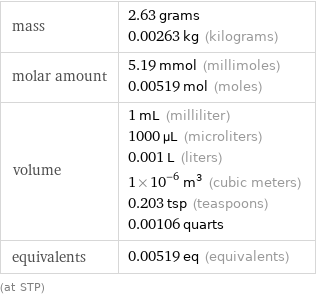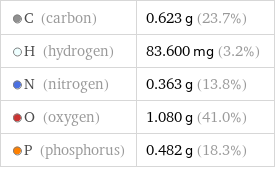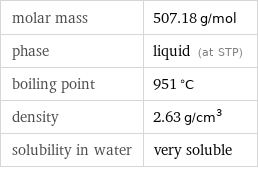Input interpretation

1 cm^3 of adenosine triphosphate
Basic properties for 1 cm^3

mass | 2.63 grams 0.00263 kg (kilograms) molar amount | 5.19 mmol (millimoles) 0.00519 mol (moles) volume | 1 mL (milliliter) 1000 µL (microliters) 0.001 L (liters) 1×10^-6 m^3 (cubic meters) 0.203 tsp (teaspoons) 0.00106 quarts equivalents | 0.00519 eq (equivalents) (at STP)
Corresponding quantities

sphere radius | 6.204 mm (millimeters) side of a cube | 10 mm (millimeters)
Thermodynamic properties for 1 cm^3

latent heat of vaporization | 0.752 kJ (kilojoules)
Phase change energies for 1 cm^3 from 25 °C

energy required to convert to vapor | 0.752 kJ (kilojoules)
Mass composition for 1 cm^3

C (carbon) | 0.623 g (23.7%) H (hydrogen) | 83.600 mg (3.2%) N (nitrogen) | 0.363 g (13.8%) O (oxygen) | 1.080 g (41.0%) P (phosphorus) | 0.482 g (18.3%)

Mass composition for 1 cm^3
Lewis structure

Draw the Lewis structure of adenosine triphosphate. Start by drawing the overall structure of the molecule, ignoring potential double and triple bonds: Count the total valence electrons of the carbon (n_C, val = 4), hydrogen (n_H, val = 1), nitrogen (n_N, val = 5), oxygen (n_O, val = 6), and phosphorus (n_P, val = 5) atoms: 10 n_C, val + 16 n_H, val + 5 n_N, val + 13 n_O, val + 3 n_P, val = 174 Calculate the number of electrons needed to completely fill the valence shells for carbon (n_C, full = 8), hydrogen (n_H, full = 2), nitrogen (n_N, full = 8), oxygen (n_O, full = 8), and phosphorus (n_P, full = 8): 10 n_C, full + 16 n_H, full + 5 n_N, full + 13 n_O, full + 3 n_P, full = 280 Subtracting these two numbers shows that 280 - 174 = 106 bonding electrons are needed. Each bond has two electrons, so in addition to the 49 bonds already present in the diagram we expect to add 4 bonds. To minimize formal charge oxygen wants 2 bonds, nitrogen wants 3 bonds, and carbon wants 4 bonds. Identify the atoms that want additional bonds and the number of electrons remaining on each atom: Add 4 bonds by pairing electrons between adjacent highlighted atoms. Additionally, atoms with large electronegativities can minimize their formal charge by forcing atoms with smaller electronegativities on period 3 or higher to expand their valence shells. The electronegativities of the atoms are 2.19 (phosphorus), 2.20 (hydrogen), 2.55 (carbon), 3.04 (nitrogen), and 3.44 (oxygen). Because the electronegativity of phosphorus is smaller than the electronegativity of oxygen, expand the valence shell of phosphorus to 5 bonds in 3 places. Therefore we add a total of 7 bonds to the diagram. Note that the six atom ring is aromatic, so that the single and double bonds may be rearranged: Answer: | |
Chemical names and formulas
![formula | C_10H_16N_5O_13P_3 Hill formula | C_10H_16N_5O_13P_3 name | adenosine triphosphate IUPAC name | [[(2R, 3S, 4R, 5R)-5-(6-aminopurin-9-yl)-3, 4-dihydroxyoxolan-2-yl]methoxy-hydroxyphosphoryl] phosphono hydrogen phosphate](../image_source/743526ff834876a001fec1fcaa3be255.png)
formula | C_10H_16N_5O_13P_3 Hill formula | C_10H_16N_5O_13P_3 name | adenosine triphosphate IUPAC name | [[(2R, 3S, 4R, 5R)-5-(6-aminopurin-9-yl)-3, 4-dihydroxyoxolan-2-yl]methoxy-hydroxyphosphoryl] phosphono hydrogen phosphate
Substance properties

molar mass | 507.18 g/mol phase | liquid (at STP) boiling point | 951 °C density | 2.63 g/cm^3 solubility in water | very soluble
Units
